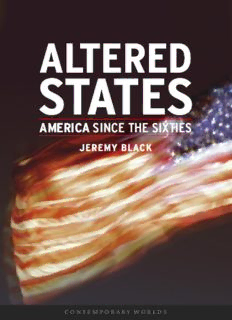
Altered States: America Since the Sixties (Reaktion Books - Contemporary Worlds) PDF
Preview Altered States: America Since the Sixties (Reaktion Books - Contemporary Worlds)
AALLTTEERREEDD SSTTAATTEESS AAMMEERRIICCAA SSIINNCCEE TTHHEE SSIIXXTTIIEESS JJEERREEMMYY BBLLAACCKK CCOONNTTEEMMPPOORRAARRYYWWOORRLLDDSS ALTERED STATES CONTEMPORARY WORLDSexplores the present and recent past. Books in the series take a distinctive theme, geo-political entity or cultural group and explore their developments over a period ranging usually over the last fifty years. The impact ofcurrent events and developments are accounted for by rapid but clear interpretation in order to unveil the cultural, political, religious and technological forces that are reshaping today’s worlds. series editor Jeremy Black In the same series Britain since the Seventies Jeremy Black Sky Wars: A History of Military Aerospace Power David Gates: War since 1945 Jeremy Black The Global Economic System since 1945 Larry Allen A Region in Turmoil: South Asian Conflicts since 1947 Rob Johnson ALTERED STATES America since the Sixties JEREMY BLACK REAKTION BOOKS For Diane Atkinson, my favourite American aunt Published by Reaktion Books Ltd 33 Great Sutton Street London ec1v 0dx www.reaktionbooks.co.uk First published 2006 Copyright © Jeremy Black 2006 All rights reserved No part ofthis publication may be reproduced, stored in a retrieval system, or transmitted, in any form or by any means, electronic, mechanical, photocopying, recording or otherwise, without the prior permission ofthe publishers. Printed and bound in Great Britain by Cromwell Press, Trowbridge, Wiltshire British Library Cataloguing in Publication Data Black, Jeremy Altered states: America since the sixties. – (Contemporary worlds) 1. United States – Social conditions – 1960–1980 2. United States – Social conditions – 1980– 3. United States – Civilization – 1945– 4. United States – Politics and government – 20th century 5. United States – Foreign relations – 20th century I. Title ISBN-13:978-1-86189-288-1 ISBN-10:1 86189 288 8 Contents Preface 7 1 Background 10 2 Changing Country 24 3 Changing People 57 4 Social Trends 81 5 Culture Wars 106 6 Politics 147 7 Imperial State 200 8 Conclusions 226 Selected Further Reading 241 Index 250 Preface I grew up in Plano . . . The word conjures up drive-ins, tract homes, waves ofheat rising from the blacktop. My years there created for me an expendable past, disposable as a plastic cup . . . On leaving home I was able to fabricate a new and far more satisfying history, full of striking, simplistic environmental influences; a colorful past, easily accessible to strangers. Donna Tartt, The Secret History(1992) A continent pretending to be a country, the usa is not only the most powerful state in the world, but also a culture and society that commands attention around the globe. This impact is a crucial part of the importance and history ofthe usa, and will be discussed in this book, but putting the country in its context cannot distract from an engagement with its character. This is to be found in the juxtaposition ofunitary and divisive pressures, which reflect and sustain the essen- tial character ofcountry, society and state. These themes are old ones, but the resulting tensions remain both far-reaching and complex in the American experience. Divisiveness can be seen as arising from a pronounced variation in regional and local cultures and environments, a variation that is sometimes expressed in antipathy. This variation is frequently underrated or simplified. In the former case, there is an essentialism seen in a tendency to treat America and the Americans as the units for discussion and analysis, or to argue that, 7 although there are important differences in both categories, these are inherent to a federal system, and anyway should not be overly stressed. At the same time, differences that are acknowledged are frequently simplified to a misleading degree. In the 1960s there was a tendency to treat difference in terms ofthe South, with the implication that the rest ofthe usa was a homogenous society. More recently, there has been a dichotomous approach to difference within the usa, in terms ofthe overlapping, but far from coterminous, tendencies of Democratic, metropolitan and counter-culture versus Republican, suburban and conformist. This approach greatly underrates the variations that exist, their importance and their complexity. So also does an emphasis on geographical regions such as the South, the West or the North-East. Each is in practice very heterogeneous, and these variations are readily apparent to those who live in particular regions. In contrast to the emphasis on divisiveness, there are powerful factors across the 3.5 million square miles of the country, aiding national integration, especially the nation-state, the constitution, consumerism, television culture and sport. These create a common currency ofexperiences and ideas that unite Americans ofvery differ- ent social, racial and geographical backgrounds. At the same time, they can also serve as spheres ofcontention, most obviously with the role of the Supreme Court as an arbitrator – and to critics a legislator by judi- cial interpretation – not only ofdifferences over the criminal law but also over a range of social and political practices and events. More generally, no singular American mood at any given time has been apparent. Instead, there have been many, many moods, depending on class, race, place, personality and other factors both collective and indi- vidual. Both the bonds of citizenship and feelings of individualism have grown stronger among Americans during the last half-century. The interplay ofdivisiveness and integration provides much ofthe history ofrecent decades. For example, the controversy over language, specifically the legal status of Spanish, owes much to the fear that dethroning English will encourage disintegrative tendencies. Conversely, affirmative action is pushed as a way to help incorporate those whose ethnic position is seen as disadvantageous, generally blacks. 8 altered states
Description: